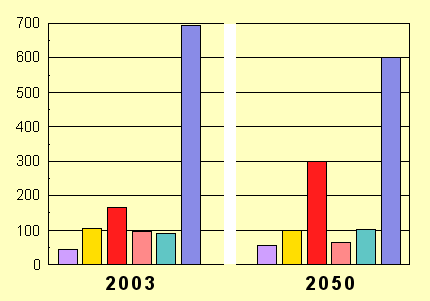|
性行為的發展
|
|
性行為的發展阶段:
青春期的性行為發展 |
|
性欲行為的發展:
5 |
|
考慮到現時愛滋病的流行和可能會導致非意願懷孕,勸告未婚青少年延遲性交也許是理智之舉,可是,從全球範圍衡量,似乎越來越少有人聽從這種勸告。世界範圍看,青春期的年齡正在下降,而結婚的年齡卻在提高。這種趨勢尤其符合發展中國家的情況,這些國家現在生活著占世界青年人人口的85%。大多數青年人對這種正在延長的婚前性受挫(sexual
frustration)感到憤憤不平。不幸的是,許多人對性傳播疾病、生殖和避孕知識知之甚少,以至於不能做出負責任的選擇。此外,青少年常常缺乏拒絕非意願的性求愛(sexual
advances)的能力和自信心。特別是年輕女性時常受到性辱虐(sexual
abuse)。這不僅在於:在許多發展中國家,社會控制的傳統機制正分崩離析,而且在於:當西方生活方式急切和常常未加批判地被採納時,長期建立起來的宗教信仰和政治理念正喪失其影響力。繼而,這種狀態有時會激起極端保守主義的激烈反抗,導致人口中各階層產生隔膜,並強化青年人的道德迷失。

2003-2050年各大區域青少年人口
直條圖所示2003年和2050年各區域的青少年人口(單位:百萬)。如圖所示,現在和將來,在撒哈拉沙漠南部非洲和亞洲/太平洋地區,青少年數量最多。(此處把10-19歲的個體定義為“青少年(adolescent)”。這個定義遵循人口統計學研究的用法;另外,在一般的表達裏,“青年人(young
people)”是指10-24歲的個體,而術語“青年(youth)”意指15-24歲的個人。)資料來源:聯合國人口活動基金會(UNFPA):http://www.unfpa.org/swp/2003/english/ch1/
|
|
 北美洲 北美洲 |
 拉丁美洲和加勒比海 拉丁美洲和加勒比海 |
 撒哈拉沙漠南部非洲
撒哈拉沙漠南部非洲 |
|
North
America |
Latin America and Caribbean |
Sub-Saharan
Africa |
|
 欧洲
欧洲 |
 阿拉伯国家区域
阿拉伯国家区域 |
 亚洲和太平洋地区
亚洲和太平洋地区 |
|
Europe |
Arab States region |
Asia and Pacific |
|
|
Adolescent population by
region 2003-2050
The graph shows the size, in millions, of the adolescent population in various regions in 2003 and 2050. As one can see, the largest numbers, now and in the future, are in sub-Saharan Africa and in the Asia/Pacific region. (“Adolescents” are here defined as being between 10 and 19 years old. This follows the usage of most demographic studies, where, in addition, the general expression “young people” refers to individuals between the ages of 10 and 24, while the term “youth” means persons between 15 and 24.)
Source: UNFPA
http://www.unfpa.org/swp/2003/english/ch1/ |
|
Development of Sexual Behavior |
|
Stages of Development: Adolescence
|
|
Erotic Behavior 5
|
|
The advice given to unmarried adolescents that they should postpone sexual intercourse may be reasonable in view of the current AIDS pandemic and possible unwanted pregnancies, but, on a global scale, it is less and less likely to be followed.
World-wide, the age of puberty is decreasing while the age of marriage is rising. This is especially true of developing countries where now 85 % of the world's young people live. Most of these resent the lengthening period of premarital sexual frustration. Unfortunately, many do not know enough about sexually transmitted diseases, reproduction and contraception to make responsible choices. Moreover, adolescents often lack the power and self-confidence to refuse unwanted sexual advances. Young females in particular are all too often sexually abused. Not only that: In many developing countries the traditional mechanisms of social control are breaking down: Long established religious and political doctrines are losing their influence while Western lifestyles are eagerly, and often uncritically, adopted. This, in turn, sometimes provokes an ultra-conservative backlash, dividing the population, and increasing the moral disorientation of the young.
|